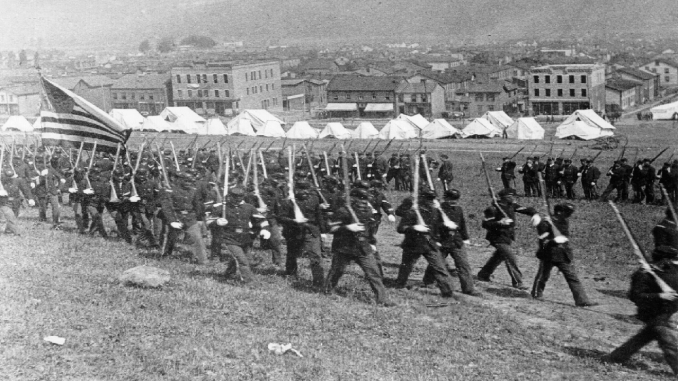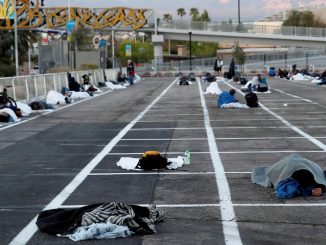
On June 25, 1892, the management of the Carnegie Steel Works in Homestead, Pennsylvania, posted notices that the men working at the works could no longer work there if they were part of a union, and that each man would have to negotiate individually with management in order to retain their job. Three days later, the Steel Works closed two sections of the plant, locking out 1,110 workers. It was clear that the owners and management intended to effectively lay off all their workers, only to reopen days later with a non-union workforce.
After those provocative acts, on July 1, the remaining 2,800 workers at the steelworks refused to report to work, officially beginning one of the most significant strikes in the late 19th century United States. Steel workers and the local working class fought heroically and were temporarily victorious against the company and its thugs, before succumbing to the power of the state. The loss of this strike condemned steelworkers to a brutal life of exploitation with no union representation for more than 40 years.
In 2023, as worker organizing and unionization drives bubble up nationwide, the successes, failures, and lessons of the 1892 Homestead Strike are well worth remembering. Here is the story of class conflict, worker solidarity, and eventual loss that took place in Homestead that year.
The Context
Homestead, Pennsylvania is located in the iron-and coal-rich Appalachian Mountains, along the Monongahela River a few miles from Pittsburgh. From the 1880s on, the region was the center of steel making in the United States, and Homestead was one of the largest steel plants in the world.
Andrew Carnegie owned the factory at Homestead, and many more in other nearby towns. He was one of the wealthiest capitalists in the United States, and Henry Frick managed his company, the Carnegie Steel Company. Frick was based in Pittsburgh and managed the day-to-day operations of the company, while Carnegie lived mostly in his mansion in New York City and travelled often to his estate in Scotland, where he could escape the pressures of the business world in the United States and play golf with his other wealthy friends.
The workers in Carnegie’s factories, on the other hand, had no such luxuries and escapes, and were conditioned to accept brutal lives of hard work. Many were immigrants, or the direct descendants of immigrants; at that time, they were mostly from Eastern Europe. They worked an average of 84 hours per week, breathed in air heavy with coal dust and regularly lost limbs, were maimed, and died in the hot, violent process of making steel out of iron. A report from just one month in 1918 give a sense of the dangers and horrors of steelmaking:
“6/6/18. Michael Kacsur…Crane chain broke and piece of steel…fell on man – killing him instantly. Crushed head.”
“6/20/18. Seniyon Jackobowsky…Turning over bloom for inspector and wick blew from torch held by inspector and set patient’s clothes on fire. Injury: 2nd and 3rd degree burns all over face, neck, arms, and body to waist. Died 2:30pm.”
“7/7/18. John Kovczun. Crane picked up ladle of molten metal from buggy…Metal splashed out on man. Injury: 2nd and 3rd degree burns of back, thigh, legs and arms, and chest. Died: 7:47am.”
It is estimated that in the late 19th and early 20th century, an average of 20 workers per year died in the works.
Although close to 4,000 workers worked in the Homestead mill in 1892, most of them were not members of a union. Despite having an undeserved reputation as a humanitarian and friend of his workers, Carnegie, like any capitalist, had worked diligently to keep unions out of his other factories. He and Frick had done so by bringing in foreign workers to replace striking iron puddlers in 1867 Pittsburgh; by using strikebreakers in his Beaver Falls factory in 1884; and using foreign workers again in 1887 at his massive Edgar Thompson works in Braddock, just a few miles from Homestead. In two instances they had used the infamous Pinkerton Detective Agency to protect these replacement workers and allow them to keep factories running despite strikes, thus enabling them to win their conflicts with their workers. In these ways and for years, they were able to use their own money and power to dominate their workforces and make millions (what would today be billions). Unfortunately, since many of Carnegie’s public pronouncements had made it seem that he cared for his workers, many of them, and many of their leaders, believed that he was their friend, while only Frick was their enemy.
800 workers at the Homestead works were represented by a union called the Amalgamated Association of Iron and Steel Workers. It represented mostly skilled workers, and refused entry to all but a handful of Black workers. Deferential to the company, elitist, patriotic, and led by business unionists in the mold of the American Federation of Labor, the union was in no way a radical organization. But in the economic circumstances of the 1890s, and faced with a drive by Carnegie and Frick to cut costs, thousands of workers would look to the Amalgamated for leadership, and would be willing to fight for that union and the larger working class of Homestead.
“The Amalgamated had to go”
Carnegie and Frick were determined to destroy this union and any form of worker organization. As they tried to modernize their factories, the union stood in the way of the company’s ability to cut jobs, increase efficiency, and cut costs. In late spring it was decided by Carnegie himself that the company would no longer bargain with the union. He gave Frick the mandate to cut the wages per ton for the Homestead workers, and encouraged him to do whatever was necessary to break the union, and in so doing, to cut costs. One of Carnegie’s partners put it clearly when he said, “the Amalgamated placed a tax on improvements, therefore the Amalgamated had to go.”
Frick began preparations to crush the union. In April of that year, he had a wall built around the entire Homestead Works, 11 feet high and three miles long, with peepholes at about eye level, perfect for firing guns through. The plan was to lock workers out, and force them, in desperation, to begin to bargain individually with the company. On June 25, after the union refused to accept the lower tonnage rate, Frick posted notices in Homestead telling workers that the company would no longer bargain with the union, only with individual workers.
At this point, the workers and the townspeople knew what was coming, and began preparations. The workers themselves took a vote, and, although only 800 were actually union members, 3,000 voted to strike. Nearly 4,000 people, most workers, but many other residents of Homestead who supported the workers, organized themselves to keep watch on the factory and surrounding towns, and to prepare for conflict. The majority of the Homestead population completely supported the strikers, and were willing to put themselves in danger to protect their right to work at the plant for what they considered decent wages.
On June 28, the company closed the workplaces of 800 men. By June 30, another workplace of 300 had been closed. On July 1, seeing what was coming, the 2,800 remaining men refused to report to work, and the strike was on.
Workers’ Solidarity and Power
The Homestead works were silent, and the workers dominated the town around the factory. In order to win their strike, the workers had to keep the expensive plant quiet, producing no steel, and therefore costing Carnegie money. For the company to win, they had to bring in workers to replace the strikers, allowing them to begin using their factory again to produce profit. That is exactly what they tried to do next.
After a few days of tense waiting, at 1:00 a.m. on Wednesday, July 6, lookouts in Pittsburgh spotted two barges moving on the Monongahela River towards Homestead. They immediately sent word to the town to prepare for conflict.
The barges were filled with 300 Pinkertons. The detective agency of the same name was not so much a detective agency as a union-busting force, sometimes used for infiltrating and causing dissension, other times for disruption, other times for simply spying, and occasionally for large scale confrontation with unions or organized workers. For this mission, they used only a few of their “regulars,” who in this case acted as officers. The majority were “specials” – poor, working-class people desperate for any money, and with little clue where they were going or what, exactly, they might be asked to do.
The plan had been that the Pinkertons would arrive unexpectedly, take the works, and solidify their ability to bring in replacement workers. But upon hearing that the barges were coming toward them, the workers and townspeople stormed the factory, taking it for themselves and forcing the Pinkertons to have to take it from them.
At about 4:00 a.m., as the sun was just beginning to cast some light over the river, the barges arrived. As the Pinkertons began to disembark, the firing started. Although it is uncertain who began the shooting, it was an intense battle that raged for nearly 12 hours. Although better armed with more modern rifles, the Pinkerton “specials” were not well trained and were pinned down on their barges from the start. The workers and townspeople fired at them from behind the walls of “Fortress Frick” (as those in Homestead had taken to calling the walled factory) and from across the river. Thousands watched from a distance, and a few thousand more armed men from Braddock and Pittsburgh marched toward Homestead to join the defense. After a violent stalemate lasting into the early afternoon, at least nine had died in the fighting – six strikers and three Pinkertons. But the Pinkertons were surrounded, with no immediate help, and terrified. They chose to surrender.
Upon surrendering, many were beaten by the workers and townspeople as they walked off the barges, eventually being guided to shelter in the town opera house. Later in the day the county sheriff arrived in town and took the Pinkertons back to Pittsburgh.
The workers had won. They had defeated the hated Pinkertons, they controlled the factory and town, and they had shown heroic solidarity with the larger working class in defense of their jobs and their homes.
But the story obviously didn’t end there. After receiving word of the defeat on July 7, Carnegie cabled back to Frick: “All anxiety gone since you stand firm. Never employ one of these rioters. Let grass grow over works. Must not fail now. You will win easily next trial.”
The Role of the State
The workers of the mill and the people of Homestead felt that they had now won a fight, and were confident that they would get their jobs back. But Carnegie, Frick, and the Pennsylvania state government had different plans.
After the county Sheriff visited Homestead on July 8 and the workers refused to allow him to take control of the factory, he cabled the Governor on July 10 that “the strikers are in control, and openly express to me and to the public their determination that the works shall not be operated unless by themselves.” That same night, the Governor mobilized 8,000 Pennsylvania state militia troops, and within twelve hours they were on their way to Homestead.
When word came that the militia was coming, the Amalgamated leaders, local leaders, and most townspeople believed this was a positive sign, because, as one of them said, “we don’t want Pinkertons here. We want the militia.”They were under the impression that the state was sending troops to help them, perhaps even defend them from the Pinkertons. They even sent out a reception committee with a brass band to meet the troops as they arrived.
This mistaken belief that the militia was there to help was abruptly squashed once the troops arrived. These were well armed troops, from the Philadelphia area, who had been trained by General William Tecumseh Sherman (of Civil War fame) specifically to quell “civil disorder” in northern cities. The officer in charge immediately told the reception committee that the workers and townspeople had “not been peaceful and law-abiding citizens” and refused to hear the band. He concluded his meeting with the committee by saying, “I want you to distinctly understand that I am master of the situation.”
Homestead was suddenly occupied. The militia formed a wall around the factory, strikers were (under obvious threat from a superior military force) removed from the plant, and strikebreakers by the hundreds were brought in from out of town and began sleeping in the works. Between July 16 and 19 the various segments of the plant went back into production, and the company announced that workers could reapply for their jobs. Most did not, choosing to remain on strike, and therefore remained unemployed as strikebreakers took their jobs under military protection. Over the coming months, hundreds of strikers would be indicted on charges ranging from rioting to conspiracy and murder. The militia remained in Homestead until mid-October, making sure that the factories were operational and that the workers’ organization was broken before leaving. Although for months hundreds of workers claimed they were still on strike, by late summer the strike was effectively over.
The workers and people of Homestead had made a terrible mistake in thinking that the state was their protector against aggression by the company. The state was, as it is today, an arm of capitalist power, and Carnegie and Frick used it with efficiency once they realized they would have to. The Governor and the commanders of the militia knew precisely what their job was in Homestead: to protect private property, and to allow owners to use that property for profit.
For the workers of Homestead and their families, the losses were very real. By mid-1893, wages for skilled workers were half what they had been prior to the strike. The 84-hour workweek remained the norm. And when the price of steel billets rose by 40% over the coming few years, the wages at Homestead rose only 10%.
The Lessons
The Homestead Strike is one of a few massive worker uprisings of the late 19th century that showed the heroism and the potential of the workers’ movement. Much like workers in the Great Strike of 1877, the Haymarket Strike of 1886, and the Pullman Strike of 1894, the workers of Homestead showed tremendous solidarity and courage. They showed that they could organize themselves and take action to defend their jobs and communities. And they showed that they could win a strike, even one that involved pitched violence.
But every one of those strikes was defeated because of the role of the state in the strike. In 1877, state militias went into action around the nation to shut down strike actions in both big cities and hundreds of small towns. More than 100 workers died in these conflicts. In Chicago in 1886, the police intervention after violence led to arrests, destruction of the strike, and eventually even executions of some strikers. In Chicago in 1894, and around the nation again, federal authorities intervened directly to end the largest railroad strike in U.S. history and break the union leading the action.
Homestead was no different. The workers were winning the struggle. They had gone on strike, stopped production, defeated an armed attack, and occupied the factory. For a few short days, they controlled the means of production in Homestead. The arrival of the militia changed all that. Once again, the armed power of the state, standing behind capitalists like Carnegie and Frick, brought an end to a potentially victorious workers’ struggle.
The workers themselves, despite having the courage to fight a battle for their jobs and community, clung to the belief that the government was a beneficent protector, and welcomed its presence, only to realize its true nature once it was too late.
The Homestead Strike belongs in the tradition of the great worker struggles of U.S. history. The solidarity and courage shown by the workers hints at the potential of the working class to take on and defeat its class enemies. But their hopeful view of the nature of the state left them unprepared for their sudden loss.
Homestead with a view of river and corner of factory, between 1900 and 1910.
Battle between Pinkertons and strikers and residents, July 6, 1892.




